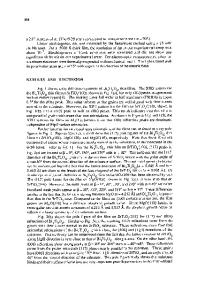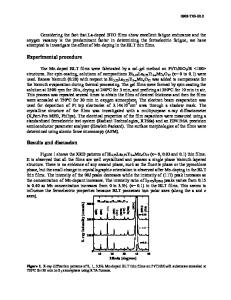Effects of the Deposition Parameters on the Structural Properties of Highly Anisotropic Bi 4-x Nd x Ti 3 O 12 Films Synt
- PDF / 1,306,012 Bytes
- 6 Pages / 595.22 x 842 pts (A4) Page_size
- 46 Downloads / 255 Views
Effects of the Deposition Parameters on the Structural Properties of Highly Anisotropic Bi4−x Ndx Ti3 O12 Films Synthesized by using Pulsed Laser Deposition Eun-Young Kim and Sang Don Bu∗ Department of Physics and Research Institute of Physics and Chemistry, Jeonbuk National University, Jeonju 54896, Korea (Received 23 June 2020; revised 23 August 2020; accepted 28 August 2020) In this study, Bi4−x Ndx Ti3 O12 (BNdT), in which neodymium is substituted into Bi4 Ti3 O12 (BiT) with a bismuth layer-structured ferroelectrics (BLSFs) structure, was deposited on a Pt/Ti/SiO2 /Si substrate by using pulsed laser deposition (PLD). The BNdT film is known to exhibit structural and electrical anisotropy with the reported maximum spontaneous polarization (Ps ) along the a axis (∼55 μC/cm2 ) and the c axis (∼5 μC/cm2 ). The ability of BNdT to control the structural change with growth orientation is key to its enhanced properties. In a PLD system, a few important factors, such as deposition temperature, oxygen pressure, and energy fluence, are responsible for the structural variation. We aimed to enhance the structural properties of polycrystalline BNdT film, so we investigated the change in the orientation of BNdT film according to PLD deposition conditions. To identify the mechanism of structural change according to deposition conditions, we used X-ray diffraction to analyze the film’s orientation and to calculate the lattice constants and the crystallite size. We also used field emission scanning electron microscopy (FE-SEM) to assess the surface morphology and the grain shape of the BNdT films. Keywords: Bismuth layer-structure ferroelectrics, Bi3.15 Nd0.85 Ti3 O12 films, PLD, Ferroelectrics DOI: 10.3938/jkps.77.1198
I. INTRODUCTION Ferroelectrics have been studied for a variety of applications including non-volatile ferroelectric random access memories (FeRAMs), sensors, actuators, ultrasonic motors, and nanogenerators [1, 2]. Among them, leadbased materials such as PbTiO3 (PTO) or Pb(Zr,Ti)O3 (PZT), which exhibit superior properties, have been actively researched worldwide due to their high remnant polarization (Pr ) and low processing temperature. However, because lead-based materials are toxic to humans and the environment, a number of materials have been investigated to replace them. Bismuth layer-structure ferroelectrics (BLSFs) have large remnant polarization, fatigue-free property, and a high Curie temperature (Tc ); thus, BLSFs have emerged as promising substitutes for lead-based materials [3, 4]. The ideal structure of BLSFs contains pseudo-perovskite (Am−1 Bm O3m+1 )2− and fluorite-like (Bi2 O2 )2+ , in which A represents mono-, di- and tri-valent cations, B is tetra-, penta- and hexavalent cations, and m is the number of perovskite layers. Also, these BLSFs are the highly anisotropy, so they can easily be grown with the c axis perpendicular to the ∗ E-mail:
[email protected]
pISSN:0374-4884/eISSN:1976-8524
film’s plane. One such material, Bi4 Ti3 O12 (BiT) has been widely reported on. Its ferroelectricity arises from the TiO6 o
Data Loading...










